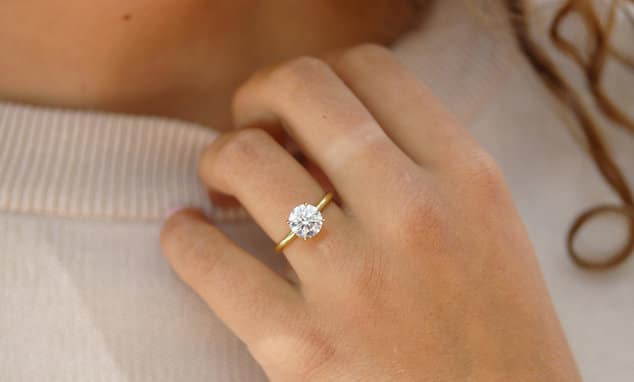
How lab grown diamonds have come to increasingly make their mark in the diamond engagement ring market.
A surprising and interesting trend has begun to make its way in the diamond industry as consumers are beginning to pay attention to synthetic diamonds — defined as diamonds grown in the lab as opposed to stones which are traditionally mined.
The shift towards lab grown diamonds mirrors consumers increased concern about the environment and moral cost of the goods they buy – and then there is also the cost advantage of choosing lab grown diamonds over mined gems, where so often exorbitant costs are simply reflecting the huge costs of excavation and mining for a gem that can now be delivered in a laboratory instead.
Recent studies reveal that the market for lab-grown diamonds increased from 1 percent of the $14 billion rough diamond market in 2016 to an estimated 2 to 3 percent today. That’s good for a whopping $280 million to $420 million in sales reports the Robb Report. The market, meanwhile, continues to grow 15% a year.
And for those who might fret that lab grown diamonds are simply not the same thing as ‘diamonds are forever’ mined from the earth, think again.
Reports Australia’s gizmodo: ‘These gems aren’t simulants or synthetic substitutes; they are optically, chemically, and physically identical to their Earth-mined counterparts. They’re also cheaper, and in theory, limitless. The arrival of lab-grown diamonds has rocked the jewellery world to its core and prompted fierce pushback from diamond miners. Claims abound on both sides.’
‘Diamonds are forever’
The growth of man-made diamonds comes as producers have finessed technology which has allowed them over the last five or so years to further harness methods for growing diamonds advanced to the point that producers began churning out large, colorless stones consistently. That’s when the jewellery sector began to take a real interest.
Production ramp-up aside, 2018 saw some other major developments across the industry. In the summer, the Federal Trade Commission (FTC) reversed decades of guidance when it expanded the definition of a diamond to include those created in labs and dropped ‘synthetic’ as a recommended descriptor for lab-grown stones.
The decision came on the heels of the world’s top diamond producer, De Beers, announcing the launch of its own lab-grown diamond line, Lightbox, after having once vowed never to sell man-made stones as jewellery. Other vendors filling the void include Clean Origin as one of the leading providers of lab-grown diamonds. Moissanite comes under the category of brands that produce pure and natural diamonds.
Understanding the differences between mined diamonds and those made in labs:
First up, a lab-grown diamond is a diamond: chemically, physically and optically identical to a mined diamond. Naturally occurring diamonds are forged in the crushing pressure and immense heat of the Earth’s mantle around 100 miles underground. Most were formed between 1bn and 3bn years ago at a time when our planet was hotter than it is today.
Lab-grown diamonds are also created using extreme pressure and heat, but inside a machine rather than the bowels of the Earth.
And while lab-grown diamonds boast the same sparkle as their Earthly counterparts, they do so at a significant discount. Morgan Stanley analyst, Paul Zimnisky writes, your typical one carat, medium quality diamond grown in a lab will sell for about $5,234, compared with $8,869 for its Earth-mined counterpart—a discount of about 40 per cent.
And instead of dissuading consumers from buying lab diamonds, who might be concerned whether steep discounts imply inferiority, buyers are in fact stepping up to the plate.
A 2018 consumer research survey by MVI Marketing found that most of those polled would choose a larger lab-grown diamond engagement ring over a smaller mined diamond of the same price.
‘The thing [consumers] seem most compelled by is the ability to trade up in size and quality at the same price,’ Garard of IGDA said.
The ethical costs
Also positing on consumer’s minds is what some describe as the ethical cost of mining diamonds, the destabilization of communities, human rights abuses, state corruption and the use of child labor in African states — notwithstanding the damage mining causes on the environment. Conversely, creating diamonds which mimic the qualities traditionally sought out by buyers (Carat Weight, Cut, Color, Clarity) serves to leave a smaller physical footprint.
Perception of luxury:
While synthetic diamonds might offer price efficiency, immediate source and transparency and devoid of moral and ethical conflict- the question remains whether man-made can match the romance of the ancient jewel, hewn from the depths, where it has lain hidden in the dark for millennia. The trick, according to one recent BBC report, is to approach one of a growing number of designer-makers working to change the system, and to get as much information as you can about how their jewellery is made: from the way it is extracted, to how it is cut, to who exactly is putting the final piece together.
The other way is to get luxury vendors to embrace lab grown diamonds as the new luxury choice item. Case in point, Meghan Markle who was observed in January in 2019 wearing diamond earrings embedded with diamonds that had been grown in a lab. It took just five days to grow the diamonds adorning Markle’s ears according to Sidney Neuhaus, co-founder of Kimaï, the company that made them.
Celebrity and royalty aside, what’s likely to continue buoying the diamond industry as a whole is ’emotion.’
When it comes to jewellery, Neuhaus says that the real value in diamonds, mined or lab-grown, is not really about price or rarity. ‘It’s more about the emotional value,” she says, fingering a long gold necklace with a green pendant on it hanging around her neck. “This was the first piece of jewellery I made for myself.” For this reason, as long as diamonds hold their emotional resonance, jewellers will continue to sell them, both lab-grown and mined.






